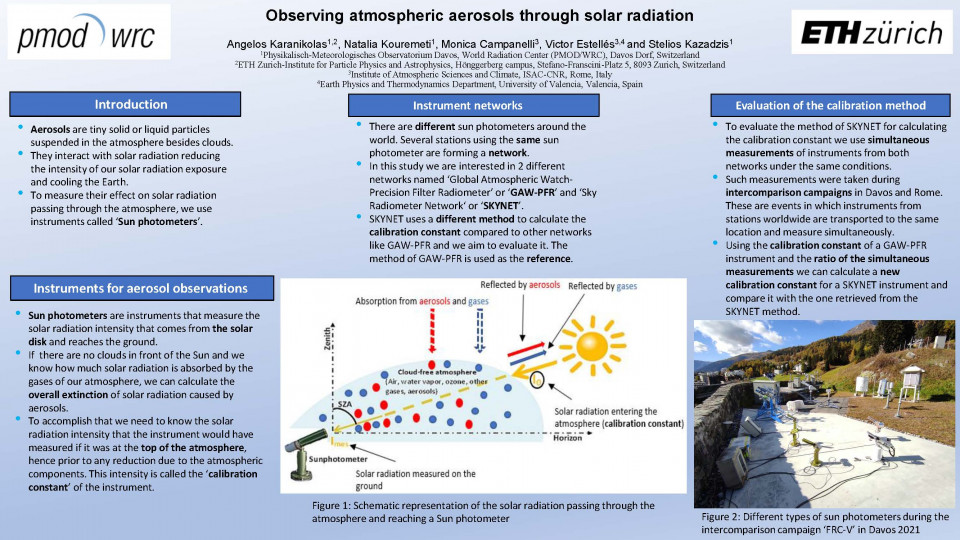Aerosols are an important atmospheric component regarding the study of atmospheric processes, which affects the Earth’s energy budget and distribution by scattering and absorbing solar and terrestrial radiation. They also play a crucial role in cloud formation and properties [Fan et al. 2016]. Their effect on solar radiation is a main driver of surface solar radiation variations for several decades [Wild 2012] hence a significant forcing of the climate [IPCC 2021]. Surface solar radiation is important for its biological effects (mainly in the Ultra Violet (UV) region) and for solar energy applications [Horneck 1995, Hou et al. 2021]. Interactions between aerosols and clouds are also important for radiative forcing attribution, climate modeling and weather forecasts [Rosenfeld et al. 2014, Glotfelty et al. 2019, Huang & Ding 2021]. Finally, aerosols are one of the most important air pollutants with various health effects [WHO 2013].
One of the most important parameters regarding aerosols is the Aerosol Optical Depth (AOD). It is the parameter that describes the aerosol column direct effect on solar radiation and the most important aerosol-related parameter for studies related to the Earth energy budget [WMO 2003], which is critical for climate studies. The AOD is observed through Sun photometers. Sun photometers are instruments that measure the direct solar irradiance reaching the ground at specific wavelengths. To retrieve the AOD through the solar irradiance on the ground, the solar irradiance at the top of the Earth’s atmosphere is required (calibration constant of a Sun photometer). Several networks of different Sun photometers have been developed worldwide in order to measure the AOD. One difference between networks aside the technical characteristics of their instrument, is calibration method (the method to estimate the solar irradiance that the instrument would measure at the top of the atmosphere).
This study aims to compare the calibration methods, for the estimation of the solar calibration constant, between the networks: Global Atmospheric Watch-Precision Filter Radiometer (GAW-PFR) (https://www.pmodwrc.ch/en/world-radiation-center-2/worcc/gaw-pfr/) and Sky Radiometer Network (SKYNET) (https://www.skynet-isdc.org/aboutSKYNET.php). The GAW-PFR instruments (Precision Filter Radiometers-PFR) are calibrated by comparison with the AOD reference triad (https://www.pmodwrc.ch/en/world-radiation-center-2/worcc/triad/) linked with the Langley Plot method (LP) in high altitude locations [Kazadzis et al. 2018]. The SKYNET instruments (Prede POM sky radiometers) are calibrated ‘on site’ with the Improved Langley Plot method (ILP) [Nakajima et al. 2020]. Intercomparisons between instruments from both networks have been conducted at Sapienza University in Rome and PMOD/WRC in Davos during the campaigns QUAlity and TRaceabiliy of Atmospheric aerosol Measurements campaign (QUATRAM) (1,2 and 3) and Filter Radiometer Comparison (FRC) (IV and V).
‘On site’ calibrations can be conducted more often, increase the instruments’ operational period, and protect the instrument from potential damages during the shipment towards and from the calibration location, but their accuracy may be reduced. Because the ILP method’s results can be affected by atmospheric conditions and therefore be dependent on the location and the time period in which the calibrations are performed. Also, the AOD is calculated from different algorithms and its intercomparison may not be sufficient to assess the performance of the method. Therefore, we compare the raw signals of PREDE-POMs and PFRs to retrieve new calibration constants for PREDE-POMs based on the PFRs’ calibration constants and use it to retrieve the AOD. The AOD retrieved using the GAW-PFR calibration transfer is compared with the AOD retrieved by the ILP for both locations in order to identify the effect of the calibration method on AOD observations. We also aim to assess the uncertainties of both methods on AOD retrieval and examine their common or different sources. Our goal is to contribute on improving the accuracy and possibly on reducing the gaps of AOD observation. Aerosols remain an important source of uncertainties in climate science [IPCC 2021] and weather forecasting [Huang & Ding 2021]. An improved aerosol monitoring can be beneficial to these scientific fields.
References
Fan, J., Wang, Y., Rosenfeld, D., & Liu, X. (2016). Review of aerosol–cloud interactions: Mechanisms, significance, and challenges. Journal of the Atmospheric Sciences, 73(11), 4221-4252.
Glotfelty, T., Alapaty, K., He, J., Hawbecker, P., Song, X., & Zhang, G. (2019). The Weather Research and Forecasting Model with Aerosol–Cloud Interactions (WRF-ACI): Development, Evaluation, and Initial Application. Monthly weather review, 147(5), 1491-1511.
Horneck, G. (1995). Quantification of the biological effectiveness of environmental UV radiation. Journal of Photochemistry and Photobiology B: Biology, 31(1-2), 43-49.
Hou, X., Wild, M., Folini, D., Kazadzis, S., & Wohland, J. (2021). Climate change impacts on solar power generation and its spatial variability in Europe based on CMIP6. Earth System Dynamics, 12(4), 1099-1113.
Huang, X., & Ding, A. (2021). Aerosol as a critical factor causing forecast biases of air temperature in global numerical weather prediction models. Science Bulletin.
Kazadzis, S., Kouremeti, N., Nyeki, S., Gröbner, J., & Wehrli, C. (2018). The World Optical Depth Research and Calibration Center (WORCC) quality assurance and quality control of GAW-PFR AOD measurements. Geoscientific Instrumentation, Methods and Data Systems, 7(1), 39.
Nakajima, T., Campanelli, M., Che, H., Estellés, V., Irie, H., Kim, S. W., ... & Soni, V. K. (2020). An overview of and issues with sky radiometer technology and SKYNET. Atmospheric Measurement Techniques, 13(8), 4195-4218.
Rosenfeld, D., Sherwood, S., Wood, R., & Donner, L. (2014). Climate effects of aerosol-cloud interactions. Science, 343(6169), 379-380.
WMO: Aerosol measurement procedures, guidelines and recommendations, GAWReport 153, WMO/TD-No 1178, available at: https://library.wmo.int/opac/index.php?lvl=notice_display&id=11085#.WpqIOOdG1PY , 2003.
World Health Organization. Regional Office for Europe. (2013). Health effects of particulate matter: policy implications for countries in eastern Europe, Caucasus and central Asia. World Health Organization. Regional Office for Europe. https://apps.who.int/iris/handle/10665/344854
Zhongming, Z., Linong, L., Wangqiang, Z., & Wei, L. (2021). AR6 Climate Change 2021: The Physical Science Basis.
